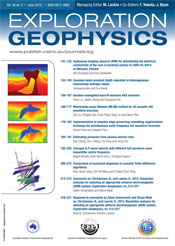
Exploration Geophysics
Volume 46 Number 2 2015
EG13057Radiowave imaging research (RIM) for determining the electrical conductivity of the rock in borehole section OL-KR4-OL-KR10 at Olkiluoto, Finland
The radiowave imaging method (RIM) was tested in the possible area for a repository of spent nuclear fuel in Finland to reveal the properties of granitic bedrock. The detected low and high resistivity zones and their apparent shapes and orientations are in fair agreement with geological and other geophysical results.
EG13061Gaussian beam prestack depth migration in heterogeneous transversely isotropic media
Based on anisotropic kinematic and dynamic ray tracing systems, an anisotropic Gaussian beam prestack depth migration method for P-wave data in transversely isotropic media is presented in this paper. Tests of synthetic and field seismic data demonstrate that the method is accurate and efficient.
EG13038Iterative reweighted least M-estimate AVO inversion
In this paper, an IRLM algorithm which uses Hampel’s three-part redescending M-estimate function as the misfit measure is proposed for robust AVO inversion. By combining the advantages of the Huber norm and biweight norm, the proposed IRLM algorithm performs better in the complex noise environment.
EG13090Memoryless quasi-Newton (MLQN) method for 2D acoustic full waveform inversion
In this paper, a memoryless quasi-Newton (MLQN) method is applied in full waveform inversion to invert velocity from surface seismic data for the first time. This method can attain acceptable results with low computation cost and small memory storage requirements. Synthetic model tests show that the MLQN method is feasible and reliable.
EG14030Implementation of adaptive edge-preserving smoothing regularisation technique for simultaneous multi-frequency full waveform inversion
An adaptive smoothing regularisation method for full waveform inversion is proposed. The proposed regularisation method is designed using the local slope and implemented in the form of a preconditioning filter for pure-gradient-based full waveform inversion. It can yield more reliable and precise inverted results compared with conventional regularisation.
EG14079Estimating primaries from passive seismic data
Passive seismic sources can generally be divided into transient and noise sources. We compare the primaries estimated from passive seismic data using transient sources and noise sources, and analyse the characteristics of the estimated primaries obtained from the two sets of passive seismic data.
EG13037Changes in P-wave velocity with different full waveform sonic transmitter centre frequency
We have studied the concept of apparent P-wave dispersion and its implications in shallow, moderately consolidated to unconsolidated sandstones. Although quantitative results of apparent P-wave dispersion were difficult to obtain from the field data, it is reasonably clear that small-scale structures are significant factors in determining variations in velocity dispersion.
EG13072Comparison of numerical dispersion in acoustic finite-difference algorithms
Different methods were developed to suppress the grid dispersion in numerical simulation of the acoustic wave equation. This paper compares the performance of these methods in the space and time–space domains. Dispersion analysis and numerical simulation indicate that a linear method without iteration performs comparably to the optimised methods.
EG13091Comments on: Christensen, N., and Lawrie, K., 2012. Resolution analyses for selecting an appropriate airborne electromagnetic (AEM) system, Exploration Geophysics, 43, 213–227
The AEM in-line component is added to the posterior model covariance matrix analysis done by Christensen and Lawrie, who estimated resolution of data in an inversion program. They compared two AEM systems: SkyTEM and CGG’s TEMPEST™. Here, we clarify points made about TEMPEST™ and extend the analysis to include the in-line component.
EG14015Response to comments by Adam Smiarowski and Shane Mulè on: Christensen, N., and Lawrie, K., 2012. Resolution analyses for selecting an appropriate airborne electromagnetic (AEM) system, Exploration Geophysics, 43, 213–227
We analyse and compare the resolution improvement that can be obtained from including x-component data in the inversion of AEM data from the SkyTEM and TEMPEST systems. Except for the resistivity of the bottom layer, the SkyTEM system, even without including x-component data, has the better resolution of the parameters of the analysed models.

